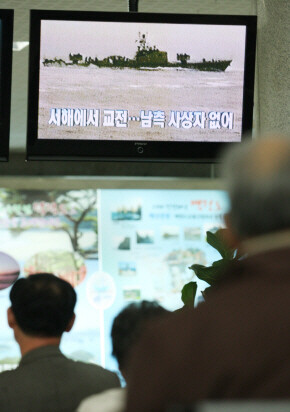hankyoreh
Links to other country sites 다른 나라 사이트 링크
North Korea and South Korea’s first naval clash in 7 years

North Korean and South Korean naval vessels exchanged fire for two minutes Tuesday morning in the waters around the Northern Limit Line (NLL) off the island of Daecheong in the West Sea. This is the third such clash between the countries and the first in over seven years, following encounters on June 15, 1999, and June 29, 2002. There were no injuries on the South Korean side from Tuesday’s exchange. A North Korean patrol boat headed back over the NLL in a partially-destroyed condition, emitting black smoke, but it is not yet known if there were any casualties.
According to the Joint Chiefs of Staff, a North Korean patrol boat traveled 2.2 kilometers past the NLL, around 11.3 kilometers east of Daecheong island at around 11:27am local time Tuesday morning. Around the time of the crossing, a total of five warning broadcasts ordering the vessel to head back north were sent, but they were ignored. A South Korean high-speed vessel sent a communication at 11:32 a.m. announcing that a warning shot would be fired, and warning shots were fired from the vessel’s guns at 11:36 a.m. in the waters about 1 kilometer ahead of the North Korean patrol boat, according to the rules of engagement, the Joint Chiefs of Staff explained.
In response, the North Korean boat discharged around 50 “sighted shots” at 11:37 a.m. toward the South Korean high-speed vessel, which was located about 3 kilometer away. The South Korean vessel immediately responded with around 100 shots from a 40mm naval gun. The entire exchange took place over a period of two minutes from 11:37 a.m. to 11:39 a.m., and the badly damaged North Korean patrol boat headed back north over the NLL at 11:40 a.m.. The South Korean vessel was hit by about 15 shots to its exterior bulkhead, between the port bridge and the steering house, but there were no casualties or damages to equipment.
Speaking in reference to the logic presented by the South Korean side, which claimed that it damaged the patrol boat severely because the North Korean boat had fired sighted shots while the South Korean vessel had only fired warning shots, an admiral in the naval reserve with experience working in the West Sea area said, “From the standpoint of the person being fired at, there is no distinction between warning shots and direct shots, and warning shots have no meaning in the military.” The admiral continued, “A ‘warning shot’ only means a shot towards a person without a gun or something like that.” The admiral added, “If you fire a warning shot, the other side is generally going to return fire.“
In a “report” issued just four hours after the incident, the Supreme Commander of the Korean People’s Army claimed that a North Korean navy patrol boat went into emergency mode “to check on an unidentified target that had infiltrated territorial waters.” At around 11:20 a.m., the report says, the South Korean naval ships “engaged in severe acts of provocation such as following behind and firing upon” the North Korean patrol boat “after it had confirmed its target and returned to its unit.” The Supreme Commander demanded that South Korean military authorities apologize and take responsible measures to avoid similar incidents in the future.
Based on the presence of Chinese fishing boats working in the area at the time of the North Korean patrol boat’s southward journey, observers are saying the boat likely crossed the NLL while cracking down on illegal fishing activity. A South Korean government official said that this incident was different from previous cases because the North Korean vessel continued traveling south despite warning broadcasts.
Please direct questions or comments to [englishhani@hani.co.kr]
Editorial・opinion
![[Column] Season 2 of special prosecutor probe may be coming to Korea soon [Column] Season 2 of special prosecutor probe may be coming to Korea soon](https://flexible.img.hani.co.kr/flexible/normal/500/300/imgdb/original/2024/0426/3317141030699447.jpg) [Column] Season 2 of special prosecutor probe may be coming to Korea soon
[Column] Season 2 of special prosecutor probe may be coming to Korea soon![[Column] Park Geun-hye déjà vu in Yoon Suk-yeol [Column] Park Geun-hye déjà vu in Yoon Suk-yeol](https://flexible.img.hani.co.kr/flexible/normal/500/300/imgdb/original/2024/0424/651713945113788.jpg) [Column] Park Geun-hye déjà vu in Yoon Suk-yeol
[Column] Park Geun-hye déjà vu in Yoon Suk-yeol- [Editorial] New weight of N. Korea’s nuclear threats makes dialogue all the more urgent
- [Guest essay] The real reason Korea’s new right wants to dub Rhee a founding father
- [Column] ‘Choson’: Is it time we start referring to N. Korea in its own terms?
- [Editorial] Japan’s rewriting of history with Korea has gone too far
- [Column] The president’s questionable capacity for dialogue
- [Column] Are chaebol firms just pizza pies for families to divvy up as they please?
- [Column] Has Korea, too, crossed the Rubicon on China?
- [Correspondent’s column] In Japan’s alliance with US, echoes of its past alliances with UK
Most viewed articles
- 1‘We must say no’: Seoul defense chief on Korean, USFK involvement in hypothetical Taiwan crisis
- 2N. Korean delegation’s trip to Iran shows how Pyongyang is leveraging ties with Moscow
- 3‘Weddingflation’ breaks the bank for Korean couples-to-be
- 4Korea sees more deaths than births for 52nd consecutive month in February
- 5[Editorial] New weight of N. Korea’s nuclear threats makes dialogue all the more urgent
- 6[Column] Has Korea, too, crossed the Rubicon on China?
- 7[Column] Park Geun-hye déjà vu in Yoon Suk-yeol
- 8[Guest essay] The real reason Korea’s new right wants to dub Rhee a founding father
- 9Amnesty notes ‘erosion’ of freedom of expression in Korea in annual human rights report
- 10[Reportage] On US campuses, student risk arrest as they call for divestment from Israel